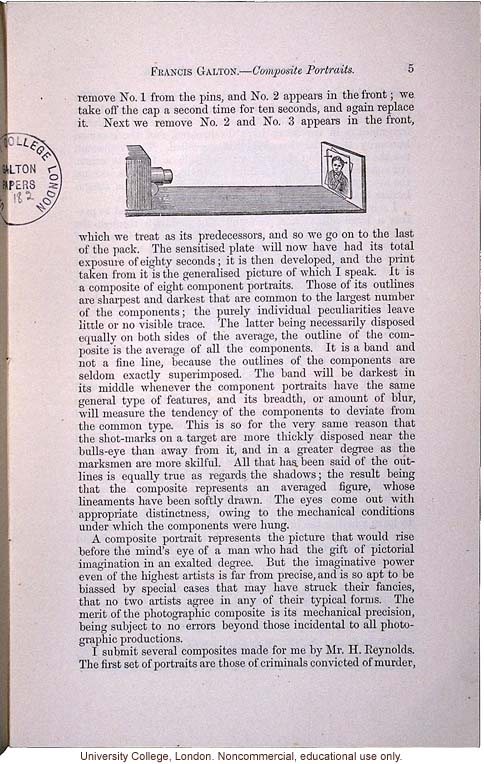Francis Galton. - Composite Portraits. 5
remove No. 1 from the pins, and No. 2 appears in the front; we take off the cap a second time for ten seconds, and again replace it. Nex we remove No. 2 and No. 3 appears in the front,
[illustration]
which we treat as its predecessors, and so we go on to the last of the pack. The sensitised plate will now have had its total exposure of eighty seconds; it is then developed, and the print taken from it is the generalised picture of which I speak. It is a composite of eight component portraits. Those of its outlines are sharpest and darkest that are common to the largest number of the components; the purely individual peculiarities leave little or no visible trace. The latter being necessarily disposed equally on both sides of the average, the outline of the composite is the average of all the components. It is a band and not a fine line, because the outlines of the components are seldom exactly superimposed. The band will be darkest in its middle whenever the component portraits have the same general type of features, and its breadth, or amount of blur, will measure the tendency of the components to deviate from the common type. This is so for the very same reason that the shot-marks on a target are more thickly disposed near the bulls-eye than away from it, and in a greater degree as the marksmen are more skilful. All that has been said of the outlines is equally true as regards the shadows; the result being that the composite represents an averaged figure, whose lineaments have been softly drawn. The eyes come out with appropriate distinctness, owing to the mechanical conditions under which the components were hung.
A composite portrait represents the picture that would rise before the mind's eye of a man who had the gift of pictorial imagination in an exalted degree. But the imaginative power even of the highest artists is far from precise, and is so apt to be biassed by special cases that may have struck their fancies, that no two artists agree in any of their typical forms. The merit of the photographic composite is its mechanical precision, being subject to no errors beyond those incidental to all photographic productions.
I submit several composites made for me by Mr. H. Reynolds. The first set of portraits are those of criminals convicted of murder,
[end]


